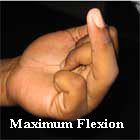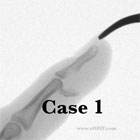|


|
synonyms: FDP avulsion, Jersey Finger, Football finger
Jersey Finger ICD-10
- S63.621A - Sprain of interphalangeal joint of right thumb, initial encounter
- S63.622A - Sprain of interphalangeal joint of left thumb, initial encounter
- S63.629A - Sprain of interphalangeal joint of unspecified thumb, initial encounter
- S63.630A - Sprain of interphalangeal joint of right index finger, initial encounter
- S63.631A - Sprain of interphalangeal joint of left index finger, initial encounter
- S63.632A - Sprain of interphalangeal joint of right middle finger, initial encounter
- S63.633A - Sprain of interphalangeal joint of left middle finger, initial encounter
- S63.634A - Sprain of interphalangeal joint of right ring finger, initial encounter
- S63.635A - Sprain of interphalangeal joint of left ring finger, initial encounter
- S63.636A - Sprain of interphalangeal joint of right little finger, initial encounter
- S63.637A - Sprain of interphalangeal joint of left little finger, initial encounter
- S63.638A - Sprain of interphalangeal joint of other finger, initial encounter
- S63.639A - Sprain of interphalangeal joint of unspecified finger, initial encounter
A- initial encounter
D- subsequent encounter
S- sequela
Jersey Finger ICD-9
- 842.13 (sprain of interphalangeal joint)
- 727.64 (Rupture of tendon, nontraumatic; flexor tendons of hand and wrist)
Jersey Finger Etiology / Epidemiology / Natural History
- avulsion of the FDP insertion into the distal phalangeal base
- football, rugby players
- tendon often avulses with a small bone fragment and retracts
- 75% occur in the ring finger. The FDP insertion into the ring finger is anatomically weaker than in the middle finger (Manske PR, Hand 1978;10;52-55)
- Generally occurs from attempted active flexion while the finger is being forcibly extended.
- Most commonly involves the ring finger.
Jersey Finger Anatomy
- Blood supply to the tendon comes from the short and long vinculae(Ochiai N, J Hand Surg 1979;4:321).
- The tendon receives most of its nutrition via synovial fluid diffusion.(Manske PR J Hand Surg 1982;7:436-444)
- Long vinculum is at the level of middle phalanx and may prevent retraction into the palm in type II injuries
- A2 and A4 pulleys prevent bowstinging and just be preserved during surgical repair
Jersey Finger Clinical Evaluation
- Specifically test isolated DIP joint flexion in all digits. The inability to flex the DIP joint is pathognomic of a Jersey Finger.
- Tenderness along the flexor tendon sheath or in the palm may indicate the level of tendon retraction.
Jersey Finger Xray / Diagnositc Tests
- A/P and lateral xrays of involved finger (not hand).
- Look for avulsed fragments of distal phalanx
- Fracture patterns are not reliable in predicting the level of tendon retraction
Jersey Finger Classification / Treatment
- Leddy and Packer classification (Leddy JP, J Hand Surg 2;66:1977)
- Type I=tendon retracted to the palm, held up by the lumbrical origin. Generally tender in palm, but able to fully flex PIP joint. Location of tendon end often corresponds to point of maximal tenderness in palm. RX=Primary repair within 10 days. After 10 days tendon likely shortened
- Type II=tendon retraced to level of the PIP joint. Generally not tender in palm, but unable to flex PIP joint. RX=Primary repair as soon as possible. Primary repair may still be possible several weeks after injury.
- Type IIIA=large bone fragment avulses and becomes caught at the entrance to the fourth annular pulley or the FDS chiasm. RX=Primary repair as soon as possible. Primary repair may still be possible several weeks after injury. Large fragment fixation via suture of mini-fragment screws as indicated.
- Type IIIB=distal phalanyx fracture combined with avulsion of tendon from the fractured bone. RX= ORIF of fracture followed by primary repair of avulsed tendon. Generally within 10 days. After 10 days tendon likely shortened
- Type IV=comminuted intra-articular fracture of the distal phalanyx.
- Chronic injuries may be treated by DIP arthrodesis, or tendon grafting in one or two stages. DIP arthrodesis is preferred due to numerous potential complications associated to grafting.
Jersey Finger Technique - Primary Repair
- CPT: 26350 (repair of flexor tendon, not in zone 2, without free graft)
- Tunnel repair with peripheral sutures provides strongest repair (Dovan TT, J Hand Surg 2005;30Am:258).
- tourniquet high on arm, pre-operative antibiotic
- Volar zigzag incision from just proximal to PIP joint to just distal to DIP joint
- Expose flexor tendon sheath
- Transverse incision just distal to A2 pulley, look for tendon
- If unable to locate tendon, make small transverse incision just proximal to A1 pulley(at the level of the distal palmar crease). Incise sheath proximal to A1 pulley, pull tendon end into wound
- Place 3-0 Prolene stitch in tendon end
- Pass small catheter(8french Red Robin)/suture passer from PIP joint incision into palm through the flexor tendon sheath.
- Pull tendon into finger past A2 pulley
- Pass tendon under A4 pulley to its distal phalanx insertion
- Prepare bone bed on distal phalanyx. Be sure to preserve palmar plate.
- Drill K-wire into distal phalangeal bone bed exiting through the mid portion of the nail plate.
- Tie suture over a button on the top of the nail plate. (alternative =suture anchor instead of bone tunnels and button)
- Irrigate
- Close wounds
- Dorsal splint with wrist in slight flexion, MP joints at 70 degrees, PIP and DIP joints in extension.
Jersey Finger Associated Injuries / Differential Diagnosis
Jersey Finger Complications
- Unstable DIP joint, Stiffness / loss of ROM, Loss of fixation / failure, Weak pinch and, grip strength, Infection, Neurovascular injury.
- Unstable DIP joint
- Stiffness / loss of ROM
- Loss of fixation / failure
- Weak pinch and grip strength
- Infection
- Neurovascular injury
Jersey Finger Follow-up Care
- Splint for 4-6 weeks
- Begin passive flexion exercises at one week
- Remove suture/button at 4 weeks and begin protected active motion
- Continue activity limitations for 12 weeks.
Jersey Finger Review References
- Green's Operative Hand Surgery
- Leddy, Hand Clin 1:77;1985
- Strickland JW, JAAOS 1995;3:55
- Moiemen NS, J Hand Surg 2000;25Br:78
|


